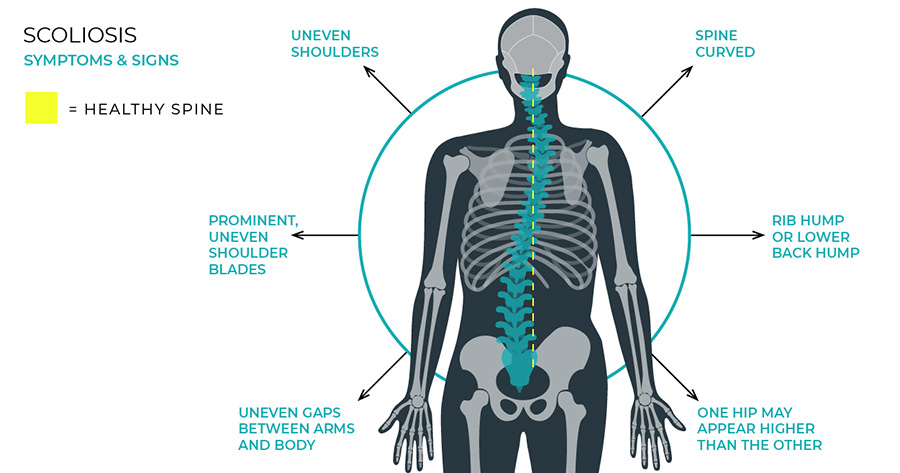Scoliosis is a condition characterized by an abnormal curvature of the spine, which can cause pain, discomfort, and functional limitations. Spinal fusion surgery is a common treatment option for severe cases of scoliosis, aiming to correct the curvature and stabilize the spine. This procedure involves fusing two or more vertebrae together using bone grafts, rods, screws, or other instrumentation. While spinal fusion can provide significant benefits in terms of correcting the curvature, it also has long-term effects that impact an individual’s quality of life and functionality.

The Long-Term Effects of Spinal Fusion Surgery
Spinal fusion surgery can have both positive and negative long-term effects on individuals with scoliosis. On the positive side, it can halt the progression of the curvature, relieve pain, and improve overall spinal stability. However, it is important to consider the potential drawbacks and challenges that may arise after the surgery.
Impact on Quality of Life: Physical and Emotional Considerations
The impact of spinal fusion on an individual’s quality of life can be significant. While the surgery can alleviate pain and improve functionality, it may also lead to physical limitations and emotional challenges. Physical considerations include restrictions in movement, reduced flexibility, and changes in posture. These limitations can affect daily activities such as bending, lifting, and participating in sports or recreational activities.
Emotionally, individuals may experience body image issues, self-esteem concerns, and feelings of isolation. The visible presence of rods or other instrumentation in the back can lead to self-consciousness and a sense of being different from others. It is crucial for healthcare professionals and support systems to address these emotional aspects and provide appropriate counseling and support.
Functional Limitations and Challenges After Spinal Fusion
After spinal fusion surgery, individuals may face functional limitations that can impact their daily lives. These limitations can include difficulties with bending, twisting, and lifting heavy objects. Activities that require a significant range of motion, such as yoga or gymnastics, may also become challenging. It is important for individuals to understand their limitations and adapt their activities accordingly to prevent further injury or strain on the fused spine.

Long-Term Effects on Mobility and Range of Motion
Spinal fusion surgery can lead to a decrease in mobility and range of motion. The fused segments of the spine become immobile, limiting the ability to bend or twist as freely as before. This can affect activities such as reaching for objects, tying shoelaces, or even getting dressed. Physical therapy and rehabilitation play a crucial role in maintaining and improving mobility after spinal fusion surgery. These interventions focus on strengthening the surrounding muscles, improving flexibility, and teaching individuals how to compensate for the limitations imposed by the fusion.
Psychological and Social Impacts of Spinal Fusion for Scoliosis
The psychological and social impacts of spinal fusion for scoliosis should not be underestimated. Individuals may experience anxiety, depression, or feelings of isolation due to the physical changes and limitations imposed by the surgery. It is important for healthcare professionals to address these psychological aspects and provide appropriate support and resources. Support groups and counseling can help individuals cope with the emotional challenges and connect with others who have undergone similar experiences.
Managing Pain and Discomfort in the Long Run
Pain and discomfort are common long-term effects of spinal fusion surgery. While the surgery aims to alleviate pain caused by scoliosis, some individuals may still experience residual pain or discomfort. This can be due to factors such as muscle imbalances, nerve irritation, or adjacent segment degeneration. Pain management strategies may include medication, physical therapy, heat or cold therapy, and alternative therapies such as acupuncture or chiropractic care. It is important for individuals to work closely with their healthcare team to find the most effective pain management approach for their specific needs.

Potential Complications and Risks Associated with Spinal Fusion
As with any surgical procedure, spinal fusion surgery carries potential complications and risks. These can include infection, bleeding, nerve damage, hardware failure, or pseudarthrosis (failure of the fusion to solidify). The risk of complications varies depending on factors such as the individual’s overall health, the complexity of the surgery, and the surgeon’s expertise. It is crucial for individuals to have a thorough understanding of the potential risks and benefits before undergoing spinal fusion surgery. Regular follow-up appointments with the surgeon are also important to monitor for any signs of complications.
Rehabilitation and Physical Therapy for Long-Term Recovery
Rehabilitation and physical therapy are essential components of long-term recovery after spinal fusion surgery. These interventions aim to improve strength, flexibility, and overall functionality. Physical therapists work closely with individuals to develop personalized exercise programs that target specific muscle groups and address individual limitations. Rehabilitation may also include modalities such as electrical stimulation, ultrasound, or traction to aid in pain management and promote healing. The duration and intensity of rehabilitation will vary depending on the individual’s specific needs and progress.
Coping Strategies and Support Systems for Individuals with Spinal Fusion
Coping with the long-term effects of spinal fusion surgery can be challenging, but there are strategies and support systems that can help individuals adapt and thrive. Developing a positive mindset, setting realistic goals, and focusing on what can be achieved rather than dwelling on limitations are important aspects of coping. Support systems, including family, friends, and support groups, can provide emotional support, understanding, and practical advice. Engaging in activities that bring joy and fulfillment, such as hobbies or creative outlets, can also contribute to overall well-being and enhance quality of life.
Enhancing Quality of Life: Adaptive Devices and Assistive Technology
Adaptive devices and assistive technology can play a significant role in enhancing the quality of life for individuals with spinal fusion. These devices can assist with activities of daily living, mobility, and independence. Examples include reachers or grabbers to retrieve objects, dressing aids to assist with getting dressed, and adaptive equipment for driving or using a computer. Assistive technology, such as voice-activated devices or smartphone apps, can also provide additional support and convenience in various aspects of life.
Future Directions: Advances in Spinal Fusion Techniques and Rehabilitation
Advances in spinal fusion techniques and rehabilitation continue to evolve, offering hope for improved outcomes and quality of life for individuals with scoliosis. Minimally invasive surgical techniques, such as robotic-assisted surgery or endoscopic approaches, aim to reduce surgical trauma and enhance recovery. Rehabilitation programs are also evolving, incorporating innovative approaches such as virtual reality or exoskeletons to improve strength, mobility, and overall functionality. Ongoing research and collaboration between healthcare professionals, engineers, and scientists hold promise for further advancements in spinal fusion techniques and rehabilitation strategies.
In conclusion, spinal fusion surgery for scoliosis has both positive and negative long-term effects on an individual’s quality of life and functionality. While it can provide relief from pain and stabilize the spine, it can also lead to physical limitations, emotional challenges, and potential complications. However, with appropriate support systems, rehabilitation, and adaptive devices, individuals can adapt and enhance their quality of life. Ongoing advancements in spinal fusion techniques and rehabilitation offer hope for improved outcomes and a brighter future for individuals with scoliosis.
Referenzen
- Weinstein SL, Dolan LA, Cheng JC, et al. "Adoleszente idiopathische Skoliose". Lancet. 2008;371(9623):1527-1537. doi: 10.1016/S0140-6736(08)60658-3.
- Negrini S, Donzelli S, Aulisa AG, et al. "2016 SOSORT guidelines: Orthopädische und rehabilitative Behandlung der idiopathischen Skoliose während des Wachstums." Skoliose und Wirbelsäulenbeschwerden. 2018;13:3. doi: 10.1186/s13013-018-0175-8.
- Trobisch P, Suess O, Schwab F. "Idiopathische Skoliose". Dtsch Arztebl Int. 2010;107(49):875-883. doi: 10.3238/arztebl.2010.0875.
- Hresko MT. "Klinische Praxis. Idiopathische Skoliose bei Heranwachsenden". N Engl J Med. 2013;368(9):834-841. doi: 10.1056/NEJMcp1209063.
- Bettany-Saltikov J, Weiss HR, Chockalingam N, et al. "Chirurgische versus nicht-chirurgische Interventionen bei Menschen mit jugendlicher idiopathischer Skoliose". Cochrane Datenbank Syst Rev. 2015;2015(4). doi: 10.1002/14651858.CD010663.pub2.
- Lonstein JE, Carlson JM. "Die Vorhersage der Kurvenprogression bei unbehandelter idiopathischer Skoliose während des Wachstums". J Bone Joint Surg Am. 1984;66(7):1061-1071. doi: 10.2106/00004623-198466070-00008.
- Kaspiris A, Grivas TB, Weiss HR, Turnbull D. "Skoliosis: Review of diagnosis and treatment". Internationale Zeitschrift für Orthopädie. 2013;37(1):34-42. doi: 10.1038/s41390-020-1047-9.
- Monticone A, Ambrosini A, Cazzaniga D, Rocca B, Ferrante S. “Brace treatment for adolescent idiopathic scoliosis: Long-term results of a randomized controlled trial.” Eur Spine J. 2016;25(10):3497-3504. doi: 10.1007/s00586-016-4398-2.
- O’Brien JP, Hsu LC. “The role of physical therapy in the management of scoliosis.” Phys Ther. 1982;62(4):537-541. doi: 10.1093/ptj/62.4.537.
- Schiller JR, Kallenbach J, Arman G. “Progression of scoliosis in children: A prospective study.” J Pädiatr Orthop. 1989;9(1):22-28. doi: 10.1097/01241398-198901000-00005.

